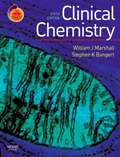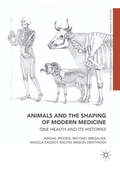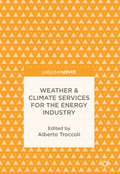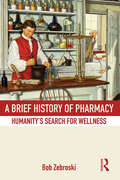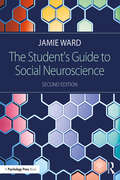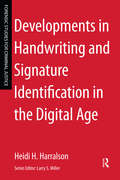- Table View
- List View
Ecosystem Services: Key Issues
by Mark EverardThe concept of ecosystem services has emerged in recent years as one of the most powerful guiding principles for ecology, biodiversity conservation and the management of natural resources. It provides the basis of assessing the multiple values and services that ecosystems can provide to humankind, including such diverse issues as carbon sequestration, flood control, crop pollination and aesthetic and cultural services. This introductory textbook sets out the key aspects of ecosystem services. The book details the historical roots of ecosystem services in the second half of the twentieth century and through initiatives such as the Millennium Ecosystem Assessment. It shows how ecosystem goods and services can be categorised and valued in economic as well as non-monetary terms, while also highlighting some of the difficulties and limitations of valuation techniques. The author describes how themes such as systems thinking, social-ecological resilience and natural capital relate to ecosystem services, and how these can contribute to more sustainable and equitable development. The book assumes limited prior knowledge and is aimed at a wide interdisciplinary audience of students across the social, environmental and life sciences. It is illustrated by a wide range of international case studies and includes learning objectives and guidance for further reading.
Ecosystem Services: Key Issues
by Mark EverardThe concept of ecosystem services has emerged in recent years as one of the most powerful guiding principles for ecology, biodiversity conservation and the management of natural resources. It provides the basis of assessing the multiple values and services that ecosystems can provide to humankind, including such diverse issues as carbon sequestration, flood control, crop pollination and aesthetic and cultural services. This introductory textbook sets out the key aspects of ecosystem services. The book details the historical roots of ecosystem services in the second half of the twentieth century and through initiatives such as the Millennium Ecosystem Assessment. It shows how ecosystem goods and services can be categorised and valued in economic as well as non-monetary terms, while also highlighting some of the difficulties and limitations of valuation techniques. The author describes how themes such as systems thinking, social-ecological resilience and natural capital relate to ecosystem services, and how these can contribute to more sustainable and equitable development. The book assumes limited prior knowledge and is aimed at a wide interdisciplinary audience of students across the social, environmental and life sciences. It is illustrated by a wide range of international case studies and includes learning objectives and guidance for further reading.
Clinical Chemistry: With Student Consult Access (PDF)
by William J. Marshall Stephen K. Bangert Márta LapsleyThis book considers what happens to the body's chemistry when affected by disease. Each chapter explains the principle involved and its application to clinical practice. In addition, there is discussion of diagnostic techniques and specific details about patient management. This book stresses how clinical chemistry relates to the practice of medicine by incorporating over 100 real patient case histories. The text is comprehensive yet succinct and is complemented by 100 full colour line illustrations. Self assessment material based on clinical vignettes is provided.
Animals and the Shaping of Modern Medicine: One Health and its Histories
by Abigail Woods Michael Bresalier Angela Cassidy Rachel Mason DentingerThis book is open access under a CC BY 4.0 license.This book breaks new ground by situating animals and their diseases at the very heart of modern medicine. In demonstrating their historical significance as subjects and shapers of medicine, it offers important insights into past animal lives, and reveals that what we think of as ‘human’ medicine was in fact deeply zoological.Each chapter analyses an important episode in which animals changed and were changed by medicine. Ranging across the animal inhabitants of Britain’s zoos, sick sheep on Scottish farms, unproductive livestock in developing countries, and the tapeworms of California and Beirut, they illuminate the multi-species dimensions of modern medicine and its rich historical connections with biology, zoology, agriculture and veterinary medicine. The modern movement for One Health – whose history is also analyzed – is therefore revealed as just the latest attempt to improve health by working across species and disciplines. This book will appeal to historians of animals, science and medicine, to those involved in the promotion and practice of One Health today.
Weather & Climate Services for the Energy Industry
by Alberto TroccoliThis open access book showcases the burgeoning area of applied research at the intersection between weather and climate science and the energy industry. It illustrates how better communication between science and industry can help both sides. By opening a dialogue, scientists can understand the broader context for their work and the energy industry is able to keep track of and implement the latest scientific advances for more efficient and sustainable energy systems. Weather & Climate Services for the Energy Industry considers the lessons learned in establishing an ongoing discussion between the energy industry and the meteorological community and how its principles and practises can be applied elsewhere. This book will be a useful guiding resource for research and early career practitioners concerned with the energy industry and the new field of research known as energy meteorology.
Weather & Climate Services for the Energy Industry
by Alberto TroccoliThis open access book showcases the burgeoning area of applied research at the intersection between weather and climate science and the energy industry. It illustrates how better communication between science and industry can help both sides. By opening a dialogue, scientists can understand the broader context for their work and the energy industry is able to keep track of and implement the latest scientific advances for more efficient and sustainable energy systems. Weather & Climate Services for the Energy Industry considers the lessons learned in establishing an ongoing discussion between the energy industry and the meteorological community and how its principles and practises can be applied elsewhere. This book will be a useful guiding resource for research and early career practitioners concerned with the energy industry and the new field of research known as energy meteorology.
Biopolitics And Social Change In Italy: From Gramsci To Pasolini To Negri (PDF)
by Andrea RighiBy placing the social dimension of labour at the base of the discourse of life, this book engages with the work of key intellectual figures and reconstructs a critical genealogy of the notion of biopolitics from the point of view of twentieth and twenty-first century Italy.
New Grade 9-1 GCSE Combined Science: Edexcel Revision Guide - Foundation (PDF)
by Cgp BooksThis fantastic CGP Revision Guide is perfectly matched to the Foundation Level Grade 9-1 Edexcel GCSE Combined Science course. Every topic is explained with clear, succinct study notes, examples and diagrams - and there are practice questions at the end of every page to test you on what you’ve learned (with answers and mark schemes included). We’ve covered all the crucial new elements of the Grade 9-1 course, including the required practicals, maths skills and Working Scientifically. What’s more, a free Online Edition of the whole book is included - just use the unique access code printed inside the cover to access it on a PC, Mac or tablet! And to make sure you’re 100% prepared for the final exams, a matching Combined Science Exam Practice Workbook is also available from CGP - see 9781782944997.
A Brief History of Pharmacy: Humanity's Search for Wellness
by Bob ZebroskiPharmacy has become an integral part of our lives. Nearly half of all 300 million Americans take at least one prescription drug daily, accounting for $250 billion per year in sales in the US alone. And this number doesn't even include the over-the-counter medications or health aids that are taken. How did this practice become such an essential part of our lives and our health? A Brief History of Pharmacy: Humanity's Search for Wellness aims to answer that question. As this short overview of the practice shows, the search for well-being through the ingestion or application of natural products and artificially derived compounds is as old as humanity itself. From the Mesopotamians to the corner drug store, Bob Zebroski describes how treatments were sought, highlights some of the main victories of each time period, and shows how we came to be people who rely on drugs to feel better, to live longer, and look younger. This accessible survey of pharmaceutical history is essential reading for all students of pharmacy.
The Student's Guide to Social Neuroscience
by Jamie WardSocial neuroscience is a rapidly growing field which explains, using neural mechanisms, our ability to recognize, understand, and interact with others. Concepts such as trust, revenge, empathy, prejudice, and love are now being explored and unravelled by neuroscientists. This engaging and cutting-edge text provides an accessible introduction to the complex methods and concepts of social neuroscience, with examples from contemporary research and a blend of different pedagogical features helping students to engage with the material, including essay questions, summary and key points, and further reading suggestions. The second edition of this ground-breaking text has been thoroughly revised and expanded to reflect the growing volume of evidence and theories in the field.?Notable additions include a greater emphasis on genetics and hormones, and the expansion of topics such as cultural neuroscience, emotion regulation, biological markers of autism, power and status, social categorization, and new accounts of mirror neuron functioning. The book is supported by a fully updated companion website, featuring student resources including lecture recordings, multiple choice questions and useful web links, as well as PowerPoint slides for lecturers. Richly illustrated in attractive full-color, with figures, boxes, and ‘real-world’ implications of research, this text is the ideal introduction to the field for both undergraduate and postgraduate students in fields such as psychology and neuroscience.
The Student's Guide to Social Neuroscience
by Jamie WardSocial neuroscience is a rapidly growing field which explains, using neural mechanisms, our ability to recognize, understand, and interact with others. Concepts such as trust, revenge, empathy, prejudice, and love are now being explored and unravelled by neuroscientists. This engaging and cutting-edge text provides an accessible introduction to the complex methods and concepts of social neuroscience, with examples from contemporary research and a blend of different pedagogical features helping students to engage with the material, including essay questions, summary and key points, and further reading suggestions. The second edition of this ground-breaking text has been thoroughly revised and expanded to reflect the growing volume of evidence and theories in the field.?Notable additions include a greater emphasis on genetics and hormones, and the expansion of topics such as cultural neuroscience, emotion regulation, biological markers of autism, power and status, social categorization, and new accounts of mirror neuron functioning. The book is supported by a fully updated companion website, featuring student resources including lecture recordings, multiple choice questions and useful web links, as well as PowerPoint slides for lecturers. Richly illustrated in attractive full-color, with figures, boxes, and ‘real-world’ implications of research, this text is the ideal introduction to the field for both undergraduate and postgraduate students in fields such as psychology and neuroscience.
Postmortem Fingerprinting and Unidentified Human Remains
by Marzena MulawkaFingerprint identification is the most efficient, rapid, and cost-effective forensic identification modality. Postmortem Fingerprinting and Unidentified Human Remains is a consolidated and thorough guide to the recovery, identification, and management of unidentified postmortem fingerprint records - topics from postmortem fingerprint processing to database submission and case management are discussed. Additionally, a postmortem processing workflow is described, which delineates various basic and advanced fingerprint recovery techniques used to acquire examination-quality records. Furthermore, Postmortem Fingerprinting and Unidentified Human Remains discusses the complexity of antemortem fingerprint databases and how to access each database for humanitarian purposes, bringing a modern value perspective to the topic.
Postmortem Fingerprinting and Unidentified Human Remains
by Marzena MulawkaFingerprint identification is the most efficient, rapid, and cost-effective forensic identification modality. Postmortem Fingerprinting and Unidentified Human Remains is a consolidated and thorough guide to the recovery, identification, and management of unidentified postmortem fingerprint records - topics from postmortem fingerprint processing to database submission and case management are discussed. Additionally, a postmortem processing workflow is described, which delineates various basic and advanced fingerprint recovery techniques used to acquire examination-quality records. Furthermore, Postmortem Fingerprinting and Unidentified Human Remains discusses the complexity of antemortem fingerprint databases and how to access each database for humanitarian purposes, bringing a modern value perspective to the topic.
Forensic Investigation of Sex Crimes and Sexual Offenders
by Chris Rush Burkey Tusty Ten Bensel Jeffery T. WalkerThe investigation of sex crimes is a specific function for many law enforcement agencies, requiring an understanding of how to investigate, process crime scenes, interact with victims and offenders, and prepare for court. Drawing on new methods of investigation and the effects of such crimes on victims, Forensic Investigation of Sex Crimes and Sexual Offenders provides in-depth coverage in these areas, offering a valuable supplement for criminal justice courses and an accessible guide for law enforcement.
Forensic Investigation of Sex Crimes and Sexual Offenders
by Chris Rush Burkey Tusty Ten Bensel Jeffery T. WalkerThe investigation of sex crimes is a specific function for many law enforcement agencies, requiring an understanding of how to investigate, process crime scenes, interact with victims and offenders, and prepare for court. Drawing on new methods of investigation and the effects of such crimes on victims, Forensic Investigation of Sex Crimes and Sexual Offenders provides in-depth coverage in these areas, offering a valuable supplement for criminal justice courses and an accessible guide for law enforcement.
Developments in Handwriting and Signature Identification in the Digital Age
by Heidi H. HarralsonThe examination of handwriting and signatures has a long and established history as a forensic discipline. With the advancement of technology in the use of digital tablets for signature capture, changes in handwriting examination are necessary. Other changes in handwriting, such as in increase in printed writing styles and the decrease in handwriting training in schools necessitates a re-examination of forensic handwriting identification problems. This text takes a fresh and modern look at handwriting examination as it pertains to forensic, legal, and criminal justice applications.
Developments in Handwriting and Signature Identification in the Digital Age
by Heidi H. HarralsonThe examination of handwriting and signatures has a long and established history as a forensic discipline. With the advancement of technology in the use of digital tablets for signature capture, changes in handwriting examination are necessary. Other changes in handwriting, such as in increase in printed writing styles and the decrease in handwriting training in schools necessitates a re-examination of forensic handwriting identification problems. This text takes a fresh and modern look at handwriting examination as it pertains to forensic, legal, and criminal justice applications.
Criminal Investigation: A Method for Reconstructing the Past
by James W. Osterburg Richard H. WardThis text presents the fundamentals of criminal investigation and provides a sound method for reconstructing a past event (i.e., a crime), based on three major sources of information — people, records, and physical evidence. Its tried-and-true system for conducting an investigation is updated with the latest techniques available, teaching the reader new ways of obtaining information from people, including mining the social media outlets now used by a broad spectrum of the public; how to navigate the labyrinth of records and files currently available online; and fresh ways of gathering, identifying, and analyzing physical evidence.
Criminal Investigation: A Method for Reconstructing the Past
by James W. Osterburg Richard H. WardThis text presents the fundamentals of criminal investigation and provides a sound method for reconstructing a past event (i.e., a crime), based on three major sources of information — people, records, and physical evidence. Its tried-and-true system for conducting an investigation is updated with the latest techniques available, teaching the reader new ways of obtaining information from people, including mining the social media outlets now used by a broad spectrum of the public; how to navigate the labyrinth of records and files currently available online; and fresh ways of gathering, identifying, and analyzing physical evidence.
Alternate Light Source Imaging: Forensic Photography Techniques
by Norman Marin Jeffrey BuszkaAlternate Light Source Imaging provides a brief guide to digital imaging using reflected infrared and ultraviolet radiation for crime scene photographers. Clear and concise instruction illustrates how to accomplish good photographs in a variety of forensic situations. It demonstrates how tunable wavelength light sources and digital imaging techniques can be used to successfully locate and document physical evidence at the crime scene, in the morgue, or in the laboratory. The scientific principles that make this type of photography possible are described, followed by the basic steps that can be utilized to capture high quality evidentiary photographs.
Alternate Light Source Imaging: Forensic Photography Techniques
by Norman Marin Jeffrey BuszkaAlternate Light Source Imaging provides a brief guide to digital imaging using reflected infrared and ultraviolet radiation for crime scene photographers. Clear and concise instruction illustrates how to accomplish good photographs in a variety of forensic situations. It demonstrates how tunable wavelength light sources and digital imaging techniques can be used to successfully locate and document physical evidence at the crime scene, in the morgue, or in the laboratory. The scientific principles that make this type of photography possible are described, followed by the basic steps that can be utilized to capture high quality evidentiary photographs.
Evolution and Behavior
by Lance Workman Will ReaderThe relationship between how we evolved and how we behave is a controversial and fascinating field of study. From how we choose a mate to how we socialize with other people, the evolutionary process has an enduring legacy on the way we view the world. Evolution and Behavior provides students with a thorough and accessible introduction to this growing discipline. Placing evolutionary psychology in context with the core areas of psychology – developmental, cognitive and social – the book explores some of the most fundamental questions we can ask about ourselves. Taking students through the principles of natural selection, it provides a nuanced understanding of key topics such as: cognitive development and the role of intelligence, memory, emotions and perception, mental health and abnormal psychology, sexual reproduction and family relationships, the development of culture. Addressing a number of controversial debates in the field, each chapter also includes concept boxes, the definition of key terms, chapter summaries and further reading. This is the ideal introductory textbook for anyone interested in evolutionary psychology. It will provide not only an essential overview of this emerging field, but also deepen readers’ appreciation of the core tenets of psychology as a whole.
Evolution and Behavior
by Lance Workman Will ReaderThe relationship between how we evolved and how we behave is a controversial and fascinating field of study. From how we choose a mate to how we socialize with other people, the evolutionary process has an enduring legacy on the way we view the world. Evolution and Behavior provides students with a thorough and accessible introduction to this growing discipline. Placing evolutionary psychology in context with the core areas of psychology – developmental, cognitive and social – the book explores some of the most fundamental questions we can ask about ourselves. Taking students through the principles of natural selection, it provides a nuanced understanding of key topics such as: cognitive development and the role of intelligence, memory, emotions and perception, mental health and abnormal psychology, sexual reproduction and family relationships, the development of culture. Addressing a number of controversial debates in the field, each chapter also includes concept boxes, the definition of key terms, chapter summaries and further reading. This is the ideal introductory textbook for anyone interested in evolutionary psychology. It will provide not only an essential overview of this emerging field, but also deepen readers’ appreciation of the core tenets of psychology as a whole.
Learning to Teach Science in the Secondary School: A companion to school experience
by Rob ToplisLearning to Teach Science in the Secondary School is an indispensable guide with a fresh approach to the process, practice and reality of teaching and learning science in a busy secondary school. This fourth edition has been fully updated in the light of changes to professional knowledge and practice and revisions to the national curriculum. Written by experienced practitioners, this popular textbook comprehensively covers the opportunities and challenges of teaching science in the secondary school. It provides guidance on: • the knowledge and skills you need, and understanding the science department at your school • development of the science curriculum • the nature of science and how science works, biology, chemistry, physics and astronomy, earth science • planning for progression, using schemes of work to support planning , and evaluating lessons • language in science, practical work, using ICT , science for citizenship, Sex and Health Education and learning outside the classroom • assessment for learning and external assessment and examinationsEvery unit includes a clear chapter introduction, learning objectives, further reading, lists of useful resources and specially designed tasks – including those to support Masters Level work – as well as cross-referencing to essential advice in the core text Learning to Teach in the Secondary School, sixth edition. Learning to Teach Science in the Secondary School is designed to support student teachers through the transition from graduate scientist to practising science teacher, while achieving the highest level of personal and professional development.
Learning to Teach Science in the Secondary School: A companion to school experience
by Rob ToplisLearning to Teach Science in the Secondary School is an indispensable guide with a fresh approach to the process, practice and reality of teaching and learning science in a busy secondary school. This fourth edition has been fully updated in the light of changes to professional knowledge and practice and revisions to the national curriculum. Written by experienced practitioners, this popular textbook comprehensively covers the opportunities and challenges of teaching science in the secondary school. It provides guidance on: • the knowledge and skills you need, and understanding the science department at your school • development of the science curriculum • the nature of science and how science works, biology, chemistry, physics and astronomy, earth science • planning for progression, using schemes of work to support planning , and evaluating lessons • language in science, practical work, using ICT , science for citizenship, Sex and Health Education and learning outside the classroom • assessment for learning and external assessment and examinationsEvery unit includes a clear chapter introduction, learning objectives, further reading, lists of useful resources and specially designed tasks – including those to support Masters Level work – as well as cross-referencing to essential advice in the core text Learning to Teach in the Secondary School, sixth edition. Learning to Teach Science in the Secondary School is designed to support student teachers through the transition from graduate scientist to practising science teacher, while achieving the highest level of personal and professional development.

